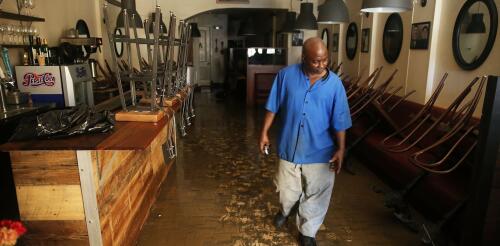Low-income
Millions of Americans have been sweltering through heat waves in recent weeks, and U.S. forecasters warn of a hot summer ahead. Globally, 2023 saw the warmest June on record, according to the European Union’s climate change service. That heat continued into July, with some of the hottest global daily temperatures on satellite record, and possibly the hottest. For people who struggle to afford air conditioning, the rising need for cooling is a growing crisis. An alarming number of Americans risk losing access to utility services because they can’t pay their bills. Energy utility providers shut off electricity to at least 3 million customers in 2022 who had missed a bill payment. Over 30% of these disconnections happened in the three summer months, during a year that was the fifth hottest on record. In some cases, the loss of service lasted for just a few hours. But in others, people went without electricity for days or weeks while scrambling to find enough money...
When a powerful storm flooded neighborhoods in Fort Lauderdale, Florida, in April with what preliminary reports show was 25 inches of rain in 24 hours, few people were prepared. Even hurricanes rarely drop that much rain in one area that fast. Residents could do little to stop the floodwater as it spread over their yards and into their homes. Studies show that as global temperatures rise, more people will be at risk from such destructive flooding – including in areas far from the coasts that rarely faced extreme flooding in the past. In many of these communities, the people at greatest risk of harm from flash flooding are low-wage workers, older adults and other vulnerable residents who live in low-lying areas and who have few resources to protect their properties and themselves. I study the impact of extreme weather on vulnerable communities as an assistant professor of social work. To limit the damage, communities need to know who is at risk and how they can be better...
How a community recovers after a disaster like Hurricane Ian is often a “chicken and egg” question: Which returns first – businesses or households? Businesses need employees and customers to be able to function. Households need jobs and the services businesses provide. As an urban planning researcher who focuses on housing recovery after disasters, I have found in my research that they’re mutually dependent. However, in coastal communities, the recovery of tourism-based businesses like restaurants and hotels depends in large part on the return of affordable housing for employees. Rockport, Texas, where Hurricane Harvey made landfall in 2017, is an example of the challenge. It’s a small community that caters to vacationers and sport fishermen, including celebrities like country singer George Strait, who filmed an ad campaign in 2018 urging tourists to return to Rockport. Drawing tourists isn’t easy without fully functioning restaurants and hot...
As mandatory evacuations for Hurricane Ian began in Florida and the warnings about damaging wind and flooding intensified, I called my aging parents to check in. Being a disaster researcher, my concern for them was already in high gear, even though they weren’t directly in an evacuation zone. My dad takes medications that require refrigeration, special needles and a sterile environment to administer. My mom is in the early stages of dementia. Both are not as spry as they used to be. I heard the worry in their voice about their safety, about my dad’s health needs, and about what might happen to their house. As I sat at home hundreds of miles away, I thought about all the reasons why leaving isn’t always a clear decision. Concerns about health and home security are two reasons older adults might fear evacuating during disasters like Hurricane Harvey in 2017. Scott Olson/Getty Images...


